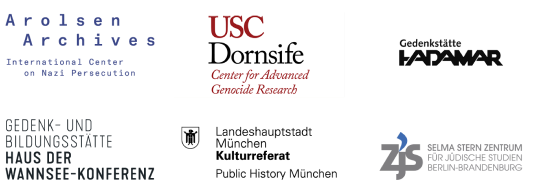Annotations
Leipzig
05/10/1942
Only picture of a deportation from Leipzig: Deportees get off a truck or trailer to board the train coming from Weimar and bound for Bełżyce. Probably this train is seen in the background. The lopsided photograph is most likely to have been taken in secret.
Annotations
People
1
Keywords
5
Historical context
Deportation von Leipzig nach Bełżyce am 10. Mai 1942
The deportation of German Jews from Leipzig on May 10, 1942 was the second one to take place after the start of systematic deportation action in 1941. Following several changes in the list of people to be deported, finally 287 residents from Leipzig and the surrounding area were deported. Among them were nine children and five caregivers from the Jewish children’s home on Jacobstraße. Prior to their departure, the deportees had to present themselves at the 32nd primary school on Yorkstraße, which was being used as an assembly camp. They were carted off from one of the city’s freight stations. On the day after their departure, auctioneers Klemm picked up the deportee’s luggage and sold it in a public sale auction. After a journey lasting two days, the train arived at Bełżyce, 20 kilometers south west of Lublin. A woman from Stettin who was interned in the town’s ghetto later remembers: “On May 12, the transport from Leipzig with more than 1,000 people aboard came to the small starved town, and that sealt everyone’s fate.” Only two Jews from Leipzig survived: Emil Wittmann, who returned to Leipzig after the war end and died there in 1954, and a woman not known by name.
About the image series
Only one photograph of the deportations of people persecuted as Jews from Leipzig has survived. It was photographed in Yad Vashem. Only the black and white negative of the photograph has been preserved. Despite the markings on the underlying pad, it is not possible to determine the format of the original print. The picture shows people forcibly marked with the star of David getting off an open truck or trailer. In the background, a passenger waggon from the deportation train coming from Weimar can be seen. The person on the right-hand corner of the picture marked by a vertical arrow was identified by a relative as Helena Siegelberg - so the provenance history. The photograph strikingly was taken at an angle, which is why what you see is slightly blurred.
Photographer
Unknown,
On his visit to the archives of the Yad Vashem World Holocaust Remembrance Center in Jerusalem in the fall of 1987, the Leipzig local historian Erwin Märtin was informed that the deportation picture had been taken by a relative of Hela Siegelberg identified in the photo. He documented this fact in the manuscript of his unpublished book about the lives and the persecution of Leipzig Jews. The photographer must have been a person who was persecuted as a Jew herself and had to take the picture in secret. To this attest the lopsidedness and blurredness of the photo. Unfortunately no information about the origin of the picture has survived in the remembrance center.
Provenance
In the early 1970s or earlier, the Leipzig deportation picture was handed to the archives of the Yad Vashem World Holocaust Remembrance Center. The identity of the donor was not documented, but the information that has survived about the photographer suggests that it was a relative or friend of the Siegelberg family. In 1973, Yad Vashem provided a copy to the Lochamei HaGetaot memorial which is also located in Israel. On a research journey to Israel in 1987, Erwin Märtin, a Leipzig local researcher, received a copy of the photo in Yad Vashem. He used the picture for an exhibition on the history of Jews in Leipzig which was shown at Karl Marx University in 1988. All previous publications of the photo failed to mention its origin.
Call number at source archive
151DO2
Title at source archive
Ohne Titel
Acknowledgements
I extend my thanks to Emanuel Saunders who was patient enough to answer my repeated questions about the archives structure of Yad Vashem, to Steffen Held, whose information has helped me approach the subject, and above all to Esther Jonas-Märtin who has granted me access to her husband’s legacy. Finally I thank Nathalie Letierce-Liebig for her archival research on the Siegelberg family.
Text and research by Lisa Paduch.
Kooperationsverbund #LastSeen. Bilder der NS-Deportationen Dr. Alina Bothe Projektleiterin
c/o Selma Stern Zentrum für Jüdische Studien Berlin-Brandenburg
Freie Universität Berlin
Habelschwerdter Allee 34A
14195 Berlin
lastseen@zedat.fu-berlin.de
Ein Kooperationsprojekt von

Gefördert durch

Datenschutz | Impressum